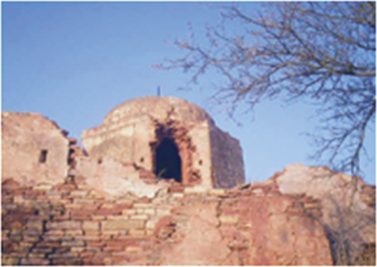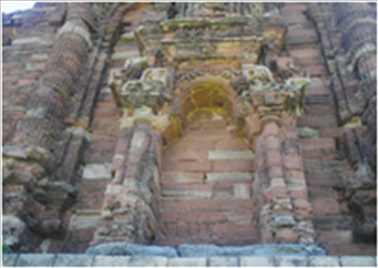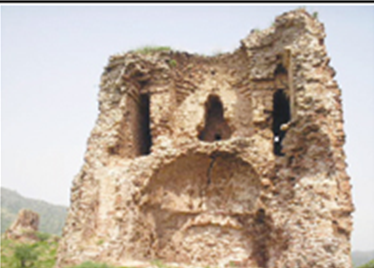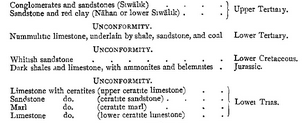Salt Range
This is a collection of articles archived for the excellence of their content. Readers will be able to edit existing articles and post new articles directly |
Salt Range
Ruins of the Salt Range
Text and photographs by Tanveerul Islam
A top the rugged hills of the Salt Range stand temples, shrines and fortresses. In ancient times emperors and princes vied for power and fought fierce battles here. Replete with history, these places are now falling apart due to neglect. Tramps and shepherds venture here using these places as half-way houses. Not many tourists come here but treasure hunters don't miss the opportunity to tear down the crumbling walls and floors in the hope of finding gold and relics.

Few are, however, attracted to the ruins of Nandna, a hilltop overlooking the village Baghanwala in district Jhelum, because of a ghost believed to be present there. There once stood a temple and a fortress built in between the sixth and eleventh century AD. Legend has it that a raja living in the fortress wanted a local girl to become part of his harem before her marriage, but the girl preferred to die and stabbed herself with a dagger and jumped down from the fort. The locals believe that her forlorn spirit still wonders around the hills.
It is also said to be the place where, in the year 1017, Abu Rehan Al Beruni spent some time to determine the circumference of the earth.
Similar ruins can be found in Malot (district Chakwal) where the Hindu Shahi kings built temples on the premises of a spectacular fortress. The fortress has disappeared and the temples are in a dilapidated state. Babur won a battle here against Daulat Khan Lodhi. Later, Mahan Singh, the father of Ranjeet Singh, also established his stronghold in this place.
Near Choa Saidan Shah is another fortress overlooking the village Kussak. Built on an oval-shaped hillock, the fortress at present is more of a jungle than a place once guarded by soldiers. The outposts have disappeared and the retaining wall too is falling off. Little is known about the people who built it except that a Janjua chieftain Sultan Fateh Mohammad Khan was the custodian of the place when Ranjeet Singh laid a siege to it. After six months, the chieftain had to surrender when his troops ran short of water. It is dangerous to visit the place, except in winters, because of the poisonous snakes found here. Besides the fortresses and temples, there were once water wells which have now disappeared except for one which exists in village Mera Aiyman, near Kalar Kahar. Placed near the remains of Fort Samarkand, it still serves as a source of drinking water for the residents. The earthen plaque found over the mouth of the pit states that it had been excavated in AD58. Inscribed in Kharwashtri language, the stone is placed in the Lahore museum.
Similarly, a baoli (a deep well with steps leading to the water level) of Sher Shah Suri’s period exists in village Waoola of district Chakwal, and is in the possession of a local influential person. One wonders how a heritage piece can be owned by an individual.
Though forgotten, these ruins can become a source of income for the locals, as well as a living record of our history if preserved properly and used as a tourist attraction.
This article has been extracted from THE IMPERIAL GAZETTEER OF INDIA , 1908. OXFORD, AT THE CLARENDON PRESS. |
Note: National, provincial and district boundaries have changed considerably since 1908. Typically, old states, ‘divisions’ and districts have been broken into smaller units, and many tahsils upgraded to districts. Some units have since been renamed. Therefore, this article is being posted mainly for its historical value.
Salt Range
Hill system m the Jhelum, Shahpur, and Mianwali Districts of the Punjab, deriving its name from its extensive deposits of rock-salt, and extending from 32 41' to 32 $6' N. and 71 42' to 73 E It was known to the ancient historians as the Makhialah hills and the Koh-i-Jud. The main chain commences in the lofty hill of Chail, 3,701 feet above sea-level, which is formed by the con- vergence of three spurs cropping up from the Jhelum river, and divided from the Himalayan outliers only by the intervening river valley. The most northern of these spurs rises abruptly from the river bank at Sultanpur, and runs nearly parallel with the Jhelum at a distance of 25 miles, till it joins the main chain after a course of 40 miles.
It bears the local name of the Nlli hills. The second spur, known as the Rohtas range, runs half-way between the Nlli hills and the river, parallel with both. It contains the fort of Rohtas, and the hill of TILL A in Jhelum District, 3,242 feet above sea-level. The third or Pabbi spur rises south of the Jhelum, dips for a while on approaching the river valley, and rises once more on the northern bank till it finally unites with the two other chains in the cential peak of Chail.
Thence the united range runs westward in two parallel ridges, till it culminates in the SAKESAR hill, on which is the sanitarium for the Districts of Shahpur, Attock, and Mianwali, 5,010 feet above sea-level. Between these lines of hills, and topped by their highest summits, lies an elevated and fertile table-land, picturesquely inter- sected by ravines and peaks. In the midst nestles the beautiful lake of Kallar Kahar. The streams which take their rise in the table-land, however, become brackish before reaching the lowlands. From Jhelum District the Salt Range stretches into Shahpur and Mianwali. The long spur which projects into Shahpur terminates m the hill of Sakesar, and comprises a number of separate rock- bound alluvial basins, the largest of which, the Sun and Khabbakki valleys, occupy the northern half, while the south consists of a broken country, cut up into tiny glens and ravines by a network of limestone ridges and connecting spurs. In the northern portion of the range, the drainage gathers into small lakes, and trees stud the face of the country; but southward, the streams flow through barren and stony gorges, interspersed with detached masses of rock, and covered with the stunted alkaline plants which grow on soil impreg- nated with salt. The Mianwali portion of the range runs north- westward towards the Indus, which it meets at Mari, opposite Kala- bagh, and rising again on the western side is continued in the Khattak-Maidani hills. The scenery throughout the range is rugged and often sublime, but wanting in softness and beauty. In many parts it becomes simply barren and uninviting.
The beds of salt, from which the range derives its name, occur in the shape of solid rock on the slopes of this table-land, and form the largest known deposits in the world. The mineral is quarried at the MAYO MINES, in the neighbourhood of the village of Khewra, a few miles north-east of Find Dadan Khan in Jhelum District, at NURPUR in Jhelum, at WARCHA in Shahpur, and at KALABAGH in Mianwali District. Coal also occurs in the Salt Range both in oolite and Tertiary strata the former at Kalabagh, and the latter between Jalalpur and Find Dadan Khan. It is of inferior quality, however, consisting of a brown lignite, difficult to burn and yielding a large proportion of ash. Besides salt and coal, other valuable minerals occur in these hills.
Few areas in India are of greater geological interest than the Salt Range, the sedimentary rocks in which have yielded fossils ranging from Cambrian to Tertiary, while the deposits of rock-salt constitute one of the most difficult problems with which the Indian geologist has to deal. A striking feature of the sedimentary beds is their marked variation in different parts of the range, and no single section affords a representative sequence. The following list of formations is compiled from a large number of sections seen in different localities :
[File: gazetteer142.png||frame|500px]]
[The following publications of the Geological Survey of India may be consulted , Records^ vols. xix, pt, li ; xxiv, pts. i and iv f xxv, pt. i ; Memoirs, vols. xiv, xvn, pt. ii } Palaeontologia Indica, Series xiii, vols, i, pts. i-vn ; iv, pts. i, ii ; and New Series i, pt. i. Also Neues Jahrbuch fur Mineralogie, &., 1896, Bd. n, p. 61 ; and 1901, Bd. xiv, p. 369.]





